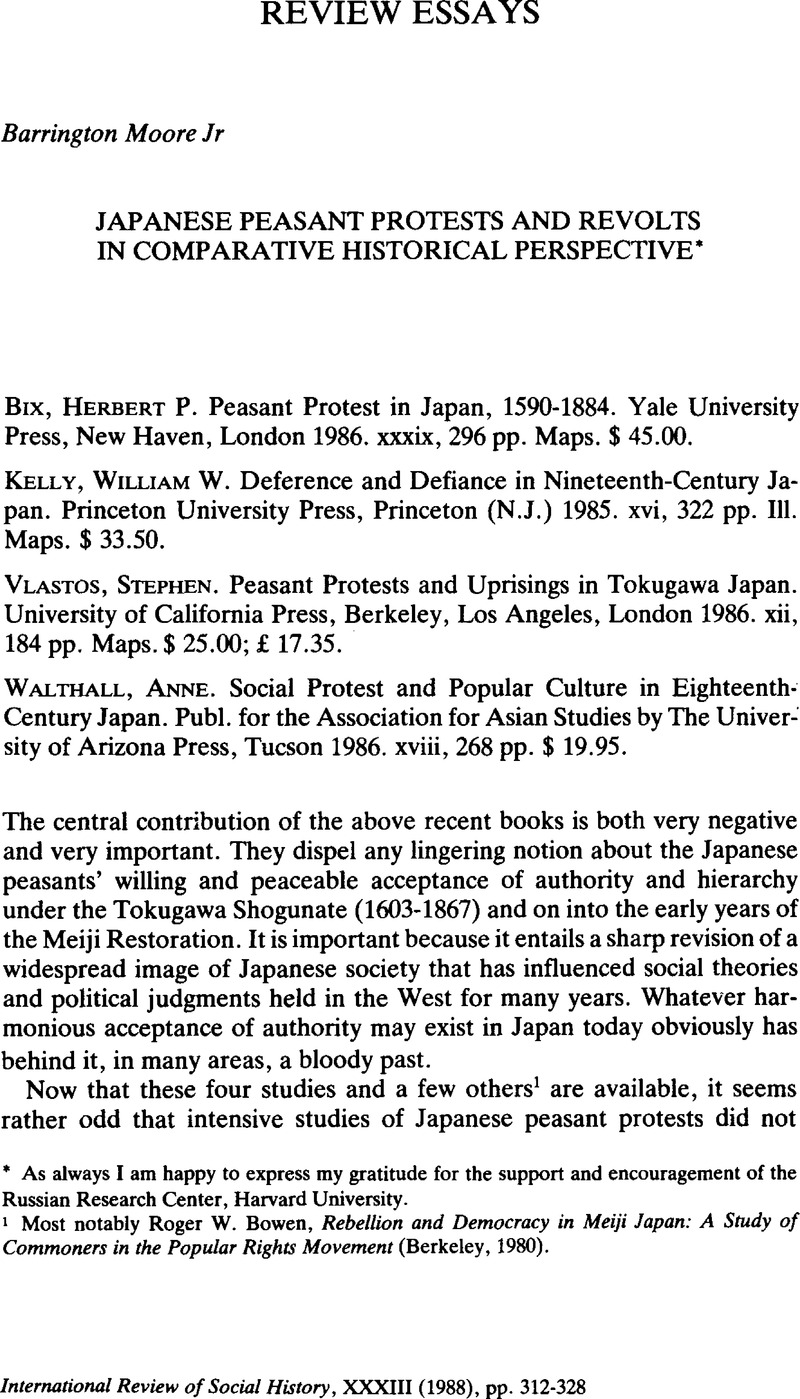Article contents
Japanese Peasant Protests and Revolts In Comparative Historical Perspective*
Published online by Cambridge University Press: 18 December 2008
Abstract

- Type
- Review essays
- Information
- Copyright
- Copyright © Internationaal Instituut voor Sociale Geschiedenis 1988
References
1 Most notably Roger Bowen, W., Rebellion and Democracy in Meiji Japan: A Study of Commoners in the Popular Rights Movement (Berkeley, 1980).Google Scholar
2 Peasant Uprisings in Japan of the Tokugawa Period, Transactions of the Asiatic Society of Japan, 2nd Series, Vol. 16 (1938). Reprinted by Paragon Book Reprint Corp. (New York, 1968).Google Scholar
3 History of Japan 1615–1867, Vol. 3 (Stanford, 1963).Google Scholar
4 Beasley, W. G., The Modern History of Japan (London, 1963), pp. 20, 25–27, 32, 34, 125.Google Scholar
5 Kelly, , Deference and Defiance, pp. 5–6.Google Scholar
6 Walthall, , pp. xiii–xiv;Google ScholarBix, , Peasant Protest, p. xxvii.Google Scholar
7 Vlastos, , p.8.Google Scholar
8 Bix, , pp. xviii–xxv, esp. Table 2 on p. xxii.Google Scholar
9 Sansom, , History of Japan, Vol. III, p. 143, mentions that the Shogunate obtained money from taxation (which, following Bix, I have also called tribute).Google ScholarBorton's discussion in Peasant Uprisings, pp. 4–5 mentions howBorton's discussion in the tax or rice collection was conducted, mainly through salaried officials (daikan), who also forwarded the taxes to Edo, where the Imperial Household was entitled to about one-fifth of the entire taxes collected.Google Scholar
10 Vlastos, , pp. 12–13.Google Scholar
11 For peasant conceptions of justice in many parts of the world see C. Scott, James, The Moral Economy of the Peasant: Rebellion and Subsistence in Southeast Asia (New Haven, 1976), pp. 176–192. Where Scott emphasizes a right to subsistence, I prefer to emphasize a right to enough material goods to carry out a “socially necessary” task, as defined in a specific society. Since Scott stresses that the right to subsistence undergoes historical change, our difference is small. The rest of my discussion is based to a great extent on Walthall's extensive analysis of peasant petitions and their notions of justice (chapters 3 and 4) and on Vlastos's treatment of benevolence by those on top (esp. pp. 15–18), views which are very close to Scott's, which he rejects (pp. 155–156).Google Scholar
12 Vlastos, , p. 28;Google ScholarBix, , pp. 13–14.Google Scholar
13 Until the end of the seventeenth century the authorities used an on-site system of assessing the tribute rate. An on-site system can be very effective in extracting a surplus, as was apparently the case in old Japan. But, if kept up to date, it is expensive to run and carries a risk of upsetting tribute payers and shaking up social stability. At the end of the seventeenth century the authorities switched to a fixed-rate system, according to Vlastos, , p. 29, n. 13Google Scholar and Walthall, , p.8, where she describes the introduction of the fixed-rate system as part of the Kyōhō reforms (1716–1736) or rather later than Vlastos.Google Scholar
14 Bix, , p. 13.Google Scholar
15 Walthall, , p. 8.Google Scholar
16 Vlastos, , p. 76;Google ScholarWalthall, , pp. 72–75.Google Scholar
17 Vlastos, , p. 157.Google Scholar
18 Bix, , pp. 140–141.Google Scholar
19 Vlastos, , p. 59.Google Scholar
20 Hashimoto Mitsuru, “The Social Background of Peasant Uprisings in Tokugawa Japan”, in Tetsuo, Najita and Victor Koschmann, J. (eds), Conflict in Modern Japanese History: The Neglected Tradition (Princeton, 1982), pp. 145–163; quotation on p. 145. The description by peasants of earlier times is suspiciously idyllic. But it is quite likely that later troubled peasants saw the past that way.Google Scholar
21 Walthall, , pp. 16–17.Google Scholar
22 Pp.143–144.
23 Bix, , pp. 144, 171.Google Scholar
24 Bix, , p. 147.Google Scholar
25 Walthall, , p. 15.Google Scholar
26 Walthall, Cf., p.85.Google Scholar
27 Walthall, , pp. 82–83.Google Scholar
28 This is explicitly stated by Hashimoto Mitsuru, “Social Background of Peasant Uprisings”, p. 163.Google Scholar
29 Vlastos, , p. 3.Google Scholar
30 Bix, , p. 228;Google ScholarVlastos, , pp. 165–166.Google Scholar
- 2
- Cited by




